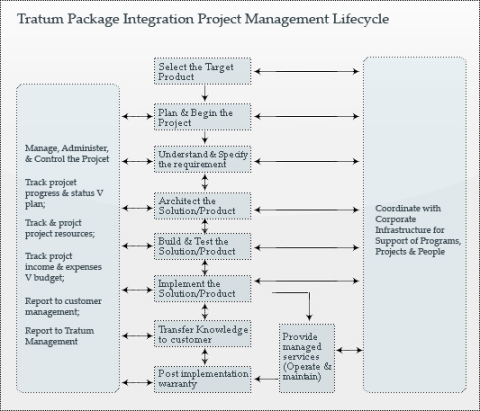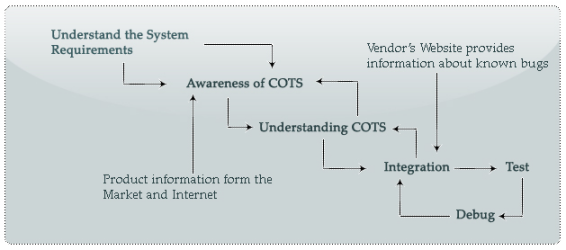COTS Implementation Experience
Our Experience
Tratum has implemented many COTS based projects across the world using our own methodology and has succeeded in each and every project with 100% customer satisfaction.

Highlights
- Product-driven, with a process orientation leveraging the COTS.
- Milestone-event driven with presentation of deliverables.
- Precise and adequate in size and scope of documentation (Make sure we do not get over sized by documentation and delay by its own weight).
- Customized for each COTS domain area. For example, a CRM implementation is more iterative than ERP as the rules are very firm and laid out in ERP domain (Not ‘One size fits all’).
- Flexible: Can accommodate new technologies and approaches (objects, external packages etc).
- Based on real-world experience dealing with global customers and implementation across the world for 15 Years.
- Emphasizes appropriate coordination points, roles, & responsibilities between customer and Tratum.
The Change Management Expertise
Tratum, with presence in the global market for over a decade, has developed expertise in developing custom solutions to specific client needs as well as constructing solutions on COTS products.
Tratum has a strong Quality Management System framework that integrates multiple processes. The framework is designed to meet development and implementation and covers processes including project planning, project management, and configuration management. It also includes a robust QA structure with inspection, audit and periodic review activity at various stages for an early detection of deviations.
Organizational processes at Tratum are defined to inculcate and sustain a process-oriented culture. We gauge performance through such measures as customer satisfaction, planning effectiveness, schedule adherence and teamwork to mention a few.
Tratum delivery procedures are stringent and well integrated into all project plans. These processes ensure validation of deliverables at each milestone before release to clients. Processes at Tratum are mapped for effective management and control for both development and implementation separately. The Tratum process model for COTS projects is as follows:
At Tratum, we have defined and implemented successfully, the processes for such effective control on the real-time needs of a typical COTS project. COTS CRM & ERP products are popular in the market for cost reduction and time saving.
Tratum through its expertise on Change Management, Awareness of the Product and the Technical skills to tailor the Package reduces the time to GO-LIVE on the selected Package with customization.
A well laid out change management procedure enables us to govern and automate the entire change and deployment process. We use our processes to define and enforce reviews, approvals, and quality standards, which in turn reduce manual touch-points, latency, and mistakes. Or, we can digitize and automate the processes. This provides a consistent, repeatable way to manage development, QA, build, release, and deployment. It also helps to digitize and enforce application development using methodologies following CMM and Six Sigma. A full audit trail ensures we can measure performance and troubleshoot bottlenecks.
Tratum process model for COTS projects is as follows:

Business Process Mapping Experience
Business process mapping starts with a thorough understanding of current business practice. This knowledge is then used to compare with the features offered by a particular product. The objective is to see if the features of that product address the requirements of the business.
A comprehensive fit-gap analysis methodology and strong business process mapping skills have helped the consultants at Tratum in implementing COTS products suitable to client’s business requirements.
The success of a COTS implementation depends on the following analyses:
- Are the client’s business processes understood correctly?
- Is the COTS product capable of meeting the client business requirements?
- What is the percentage gap between the business process requirements and the product?
- What is the customization percentage estimate?
- What is the impact to customization, upgrades, and future releases of COTS?
Tratum considers fit-gap analysis to be one of the most important activities for implementation as it defines the scope of project.
As per our experience, we have found that fit-gap analysis ends with one of the following outcomes;
- Meets the expectations AS-IS – Customer requirements are matched by COTS package and is configured accordingly.
- Minimum Customization– Changes to labels, colors, visual element changes, etc.
- Heavy Customization– Logical changes made to the product delivered workflow, adding new screens, changing and adding business logic, adding entities to databases, etc.
- Not Supported– Identifies the functional business processes not supported by the product.
- Build Outside– Not supported processes may be built outside the box but can be integrated, build new features in, e.g., 3GL, non-supported add on, etc.
- External Linkage– Connectors, adapters, and interfaces to an external self-sustaining system through API. The delivery of each implementation depends upon the fit-gap analysis as per the above observations.
Fit-Gap Analysis Process followed by Tratum
Considerable project time is dedicated to the AS-IS study, allowing the business analyst and SMEs to discuss current practices with the functional owners. Tratum has functional experts who leverage their experience and expertise to capture details of the processes that are relevant to the project. This information helps in interpreting the business requirements into the product functionality and also helps in arriving at an initial estimate of limitations and customization requirements in the next phase (Target Model - Customized).
Process flow diagrams and questionnaires are used to capture the business process details and are documented to reflect the business vision in the practices. Current process structure and reports used in the process are also captured in the AS-IS Model. Unique practices and best practices of the company are captured in this phase for later reference. This phase helps in detailed assessment of the business process needs. The AS-IS study is completed with review and possible corrections from the client. A presentation is given to the client management team to re-iterate that Tratum has understood the requirements and limitations correctly.
Considering process expectations and limitations in the COTS product, a workable solution is designed to meet the client business needs. For all unique process requirements that are not available in the product,
Tratum project team takes the initiative to discuss the limitations with the COTS vendor to find a solution. Tratum project team also takes into consideration whether any workarounds are available from previous implementations.
Gaps are identified for customizations to be done within the COTS product and those to be done outside the product.
A spreadsheet list is developed to identify the total customization requirement and the effort required to fulfill the same. This estimate helps in scheduling the piloting and go-live dates.
Thus, a consolidated Target Model is developed to completely meet the client business requirements.
The Model is reviewed with the client for acceptance and approval for construction, configuration and integration. Included in the review will be the server configuration and the network design that supports business processes effectively.
In addition to mapping the process requirements with respect to product capabilities, Tratum has re-engineered processes and formulated alternative process design options capable of achieving breakthrough performance.
Based on the approved Target Model (customized), a baseline system is configured on the COTS product. Customization on the baseline is done to meet the other requirements including workarounds. The initial configuration is based on the legacy practices, which are to be mapped on the baseline system which gives a real-world view of how the business transactions will actually run. Integration of other COTS products is also taken up.
A dedicated team conducts regression testing at the client site after each customization and integration. Real time transactions along with destructive test cases are simulated on the product to check integration effectiveness. After testing, the client’s user group runs pilot transactions on the product and reports bugs to Tratum development team for fixing. At the end of this phase, the user group reports the first set of pilot transactions to the management for sign–off. Sets of reports that represent the business process coverage are submitted to the client at this stage.
For more information on Tratum’s project experience in Packages implementations, and to find how Tratum could provide you the right support that you are looking for, please contact us at sales@tratumtech.com